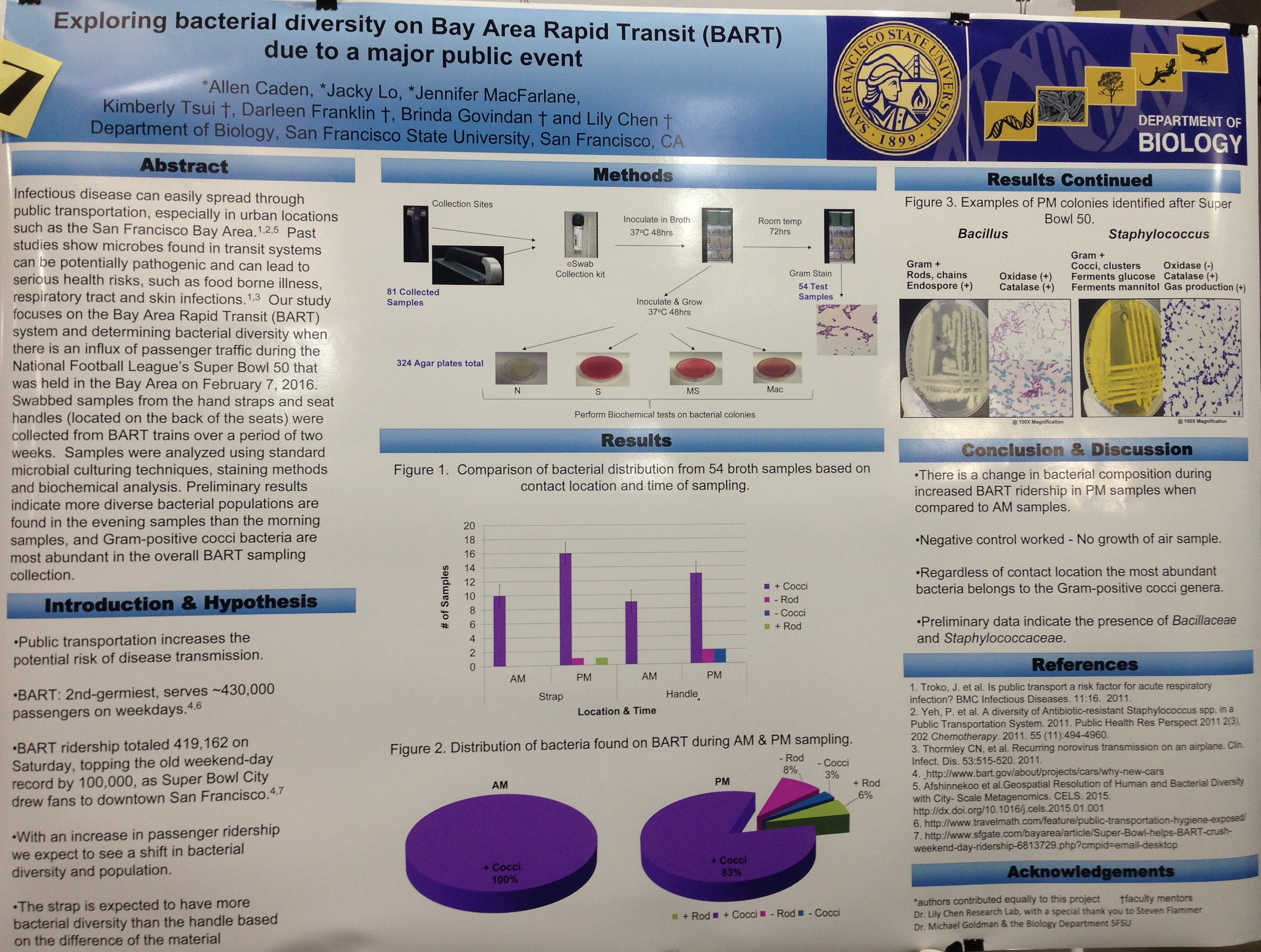Research and Selected Publications
Dr. Chen's Research
Despite advances in science and technology that have transformed the public health sector by increasing life expectancy and reducing morbidity, diseases caused by infectious microbes continue to pose a significant threat to human health. Dr. Chen’s long-term research goal is to contribute to the elimination of threats to global health through new scientific discoveries. Her current research focuses on pathogenesis, microbial gene expression/regulation, drug resistance, and educational outreach for the prevention of diseases that threaten public health.
Dr. Chen’s Ph.D. studies in molecular microbiology at the University at Buffalo-State University of New York (SUNY) characterized animal parasite Schistosoma mansoni developmentally regulated female-specific gene that encodes an eggshell protein. She then received a National Institutes of Health (NIH) Individual National Research Service Postdoctoral Fellowship to study the structure and interactions of the human immunodeficiency virus Tat protein and viral TAR RNA. Dr. Chen began her tenure-track faculty career in the Department of Biomedical Technologies at the University of Vermont (UVM) in Burlington, Vermont in 1995. She taught undergraduate microbiology courses, oversaw the clinical practicum in medical microbiology, and was elected to the Graduate College. Her research program centered on signal transduction pathways in Bovine Immunodeficiency Virus-Infected cells with National Science Foundation funding (through Stimulate Competitive Research Receptor Mediated Signaling and Biotechnology Cluster). Dr. Chen also conducted research on the epidemiology of the bovine leukemia virus and its correlation with cell death in a naturally infected dairy herd at UVM.
In 1998, Dr. Chen accepted a tenure track assistant professor position at SFSU with the Center for Biomedical Laboratory Science (CBLS), where her research focused on viral gene regulation and on screening novel HIV Rev protein inhibitors. Her research was funded by National Institutes of Health Minority Biomedical Research Support and Support of Continuous Research Excellence (SCORE) award (2003-2005). In 2004, CBLS merged with the Department of Biology, where Dr. Chen assumed additional responsibilities in student research training and transitioned the focus of her research to bacterial pathogenesis and drug resistance to better serve the needs of the department. Over the past 15 years, Dr. Chen has been the primary mentor and thesis advisor of more than 100 students, some subsequently entered Ph.D. programs. Others have gone on to health professional programs in medicine, dentistry, public health, and clinical laboratory science, while still others joined the workforce in various life science disciplines immediately upon graduation.

Selected Peer-reviewed Publications (* indicates SFSU student)
- Jenkins, S*, Fischer, S.M., Chen, L., Sana, T.R. (2013) Global LC/MS metabolomics profiling of calcium stressed and immunosuppressant drug treated Saccharomyces cerevisiae. Metabolites. 3, 1102-1117.
- Cohen, M.F., Hare, C., Kozlowski, J., McCormick, R. S*, Chen, L., Schneider, L., Parish, M., Knight, Z., Nelson, T.A.,Grewell, B. J. (2013): Wastewater polishing by a channelized macrophyte-dominated wetland and anaerobic digestion of the harvested phytomass, Journal of Environmental Science and Health, Part A: Toxic/Hazardous Substances and Environmental Engineering, 48:3, 319-330.
- Nakamura R.L., Landt S.G., Mai E*, Nejim J., Chen L., Frankel, A.D. (2012) A cell-based method for screening RNA-protein interactions: Identification of Constitutive Transport Element-interacting proteins. PLoS ONE, 7(10): e48194.
- Al-Nimir, S*, Miller, W., Byrne, B., Guibert, G., Chen, L. (2009) A unified approach to molecular epidemiology investigations: Tools and patterns in California as a case study for endemic shigellosis. BMC Infectious Diseases. 9:184.
- Kiang, D., Newbower, E.C*, Yeh, E., Wold, L., Chen, L., Schnurr, D. (2009) An algorithm for the typing of enteroviruses and correlation to serotyping. Journal Clinical Virolology. 45:334-340.
- Das, C., Edgcomb, S.P., Peteranderl, R., Chen, L., Frankel, A.D. (2004) Evidence for conformational flexibility in the Tat:TAR recognition motif of cyclin T1.Virology 318: 306-317.
- Smith, C.A., Chen, L., and Frankel, A.D. (2000) Using peptides as models of RNA protein interactions. Methods in Enzymology: RNA-ligand interactions, Part B: Molecular biology methods, 318:423-438.
- Tao, J., Chen, L., Frankel, A.D. (1997) Dissection of the proposed base triple in HIV TAR RNA indicates the importance of the Hoogsteen interaction. Biochemistry 36: 3491-3495.
- Puglisi, J.D., Chen, L., Blanchard, S., Frankel, A.D. (1995) Solution structure of a Bovine Immunodeficiency Virus Tat-TAR peptide-RNA complex. Science 270: 1200-1203.
- Chen, L., Frankel, A.D. (1995) A peptide interaction in the major groove of RNA resembles protein interactions in the minor groove of DNA. Proceedings of the National Academy of Sciences of the United States of America 92: 5077-50812.
- Chen, L., Frankel, A.D. (1994) An RNA-binding peptide from Bovine Immunodeficiency Virus Tat protein recognizes an unusual RNA structure. Biochemistry 33: 2708-2715.
- Tan, R., Chen, L., Buettner, J.A., Hudson, D., and Frankel, A.D. (1993) RNA recognition by an isolated a - helix. Cell, 73:1031-1040.
- Puglisi, J.D., Chen, L., Frankel, A. D. and Williamson, J. R. (1993) Role of RNA structure in arginine recognition of TAR RNA. Proceedings of the National Academy of Sciences of the United States of America 90: 3680-3684.
- Chen, L., Rekosh, D.M., and LoVerde, P.T. (1992) Schistosoma mansoni p48 eggshell protein gene: characterization, developmentally regulated expression, and comparison to the p14 eggshell protein gene. Molecular and Biochemical Parasitology, 52:39-52.
- LoVerde, P.T. and Chen, L. (1991) Schistosome female reproductive development. Parasitology Today 7(11): 303-308.
- Chen, L., Wu, L-L., Lee, N. and Tsai, W-C. (1985). A simple method for performing yeast carbohydrate assimilation test. Chinese Journal of Microbiology and Immunology 18(4): 72-77.

